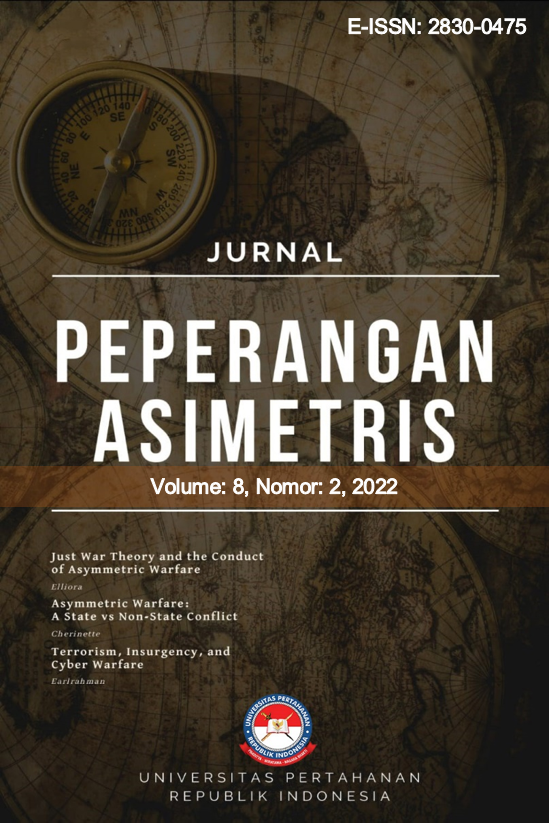TEKNOLOGI BLOCKCHAIN DALAM KAJIAN PEPERANGAN ASIMETRIS: PERSPEKTIF INDONESIA
DOI:
https://doi.org/10.33172/pa.v8i2.1435Abstract
Technological advances are changing the face of war and how we prepare for it. Blockchain, as a technological breakthrough in the field of information technology, opens up numerous opportunities for research and application in a variety of fields. Using a qualitative descriptive method, this paper aims to provide an overview of the opportunities and threats presented by the presence of blockchain technology in the study of asymmetric warfare. The study's findings are expected to be considered when making decisions to implement blockchain technology in the defense sector in Indonesia as an anticipatory strategy against asymmetric warfare. The benefits and negative impacts brought about by the emergence of blockchain technology are the indicators used in this research to explore the problems. According to the findings of this study, blockchain technology can be used to improve cybersecurity, reduce single points of failure in emergency decision-making systems, improve supply chain and logistics operations efficiency, increase the transparency of audits of procurement of goods and services, protect weapon systems and digital infrastructure, secure unmanned aerial vehicle (UAV) and swarm systems, and validate orders and battle information. However, blockchain technology has a negative impact due to its potential to be used for various cryptocurrencies-related cybercrime.References
Adams, V. (2019). Why Military Blockchain is Critical in the Age of Cyber Warfare: 4 ways blockchain can secure and defend key military assets and weapons systems. Consensys.
Barnas, N. B. (2016). Blockchains In National Defense: Trustworthy Systems In A Truthless World.
Chatterjee, R., & Chatterjee, R. (2018). An Overview of the Emerging Technology: Blockchain. Proceedings - 2017 International Conference on Computational Intelligence and Networks, CINE 2017, 126–127. https://doi.org/10.1109/CINE.2017.33
Clausewitz, C. von. (1873). https://www.clausewitz.com/readings/OnWar1873/TOC.htm. Clausewitz, On War Trans. COL James John Graham (London: N. Trübner, 1873).
Marpaung, C. O. P. (2020). Kebijakan Pengembangan IPTEK Industri Pertahanan Untuk Pembangunan Nasional.
Rizaty, M. (2021). Daftar Negara Pemilik Satelit Terbanyak di Asia, Indonesia Peringkat Berapa? Https://Databoks.Katadata.Co.Id/Datapublish/2021/09/27/Daftar-Negara-Pemilik-Satelit-Terbanyak-Di-Asia-Indonesia-Peringkat-Berapa.
Sugiyono. (2016). Metode Penelitian Kuantitatif, Kualitatif dan R&D. PT. Alfabeta.
Sutrisno, B. (2018). Blockchain dan Cryptocurrency: Peran Teknologi Menuju Inklusi Keuangan?. Repositori Penelitian Universitas Terbuka.
The Value Technology Foundation. (2020). Potential-Uses-of-Blockchain-Technology-In-DoD. Potential Uses of Blockchain By The U.S. Departement of Defense, Washington D.C.
Walzer, Michael. (2006). Just and unjust wars : a moral argument with historical illustrations. Basic Books.
Downloads
Published
How to Cite
Issue
Section
License
Proposed Policy for Journals That Offer Open Access. Authors who publish with this journal agree to the following terms:
- Authors retain copyright and grant the journal right of first publication with the work simultaneously licensed under a Creative Commons Attribution License that allows others to share the work with an acknowledgment of the work's authorship and initial publication in this journal.
- Authors are able to enter into separate, additional contractual arrangements for the non-exclusive distribution of the journal's published version of the work (e.g., post it to an institutional repository or publish it in a book), with an acknowledgment of its initial publication in this journal.
- Authors are permitted and encouraged to post their work online (e.g., in institutional repositories or on their website) prior to and during the submission process, as it can lead to productive exchanges, as well as earlier and greater citation of published work (See The Effect of Open Access).
Proposed Policy for Journals That Offer Delayed Open Access. Authors who publish with this journal agree to the following terms:
- Authors retain copyright and grant the journal right of first publication, with the work [SPECIFY PERIOD OF TIME] after publication simultaneously licensed under a Creative Commons Attribution License that allows others to share the work with an acknowledgment of the work's authorship and initial publication in this journal.
- Authors are able to enter into separate, additional contractual arrangements for the non-exclusive distribution of the journal's published version of the work (e.g., post it to an institutional repository or publish it in a book), with an acknowledgment of its initial publication in this journal.

